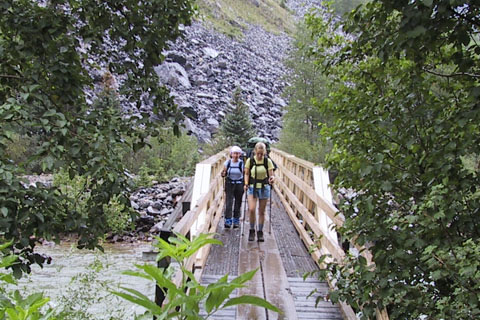| 381 | LNT - Interaction | 2011-04-25 |

The Leave No Trace Principles are ethics. Unless you are hiking in a National Park there is little chance someone would notice and even less chance someone would care if you were not following the Principles. Following the Principles is not easy.
A few examples:
Your feet are finally dry, the trail crosses through a low land and huge puddles have collected on the trail. The LNT ethic is to stay on the trail; but it is more natural and dryer to not walk through the standing water. No one is watching and it looks as if others have stepped off of the trail ...
In a wilderness area the land manager's area rules suggests that hikers pack out their tp. While hiking you leave your pack near the trail and walk two hundred feet off of the trail to dig a hole. After tending to business in the cleanup process you find that you do not have the bags for the used tp with you. No one is watching, you could just bury the paper. No one would know ...
After a long hard day of hiking you finally arrive at your camp. You are tired and barely have the energy to eat. You finally cook your dinner; but don't have the energy for cleanup and storage chores. You are pretty sure there are no bears in the vicinity. You could just take your chances with the smaller animals. No one would know that ...
You brought your dog with you on a hike but he is constantly tugging on the leash. He wants to run. He needs his wild time too. No one would know if you let him ...
Following the Leave No Trace Principles is a never ending interaction with the environment. When we are hiking we essentially make ethical decisions with each step! In each example, you, the hiker, has to make ethical decisions. On the trail we make similar decisions each step of the way.
Here are a few tips to help follow the Principles ...
The first Leave No Trace Principle is Plan and Prepare. It is number one for a reason. If you do not plan and prepare; then you will put yourself in no win situations. You can become almost forced to violate some of the other Principles.
Discuss the Leave No Trace Principles while you are walking. Talking over the Principles keeps them fresh.
If on a group hike, talk over hiking decisions with everyone, such as where to take breaks etc.
The more experienced you are, the easier it is to follow the Principles.
Experience also gives you toughness. Often times you will need to call on toughness to be able to stick by your principles. For example, when you are wet, tired, and cold a fire would solve all your ills, except fires are not allowed. Toughness gives you the edge to resist fudging the rules.
As you grow stronger (physically) as a hiker, you will be better equipped to both hike and have the energy to follow the Principles.
Continue to study the Leave No Trace Principles and other ethics.
Your interaction with the environment begins the moment you set foot on the trail and ends when you leave the area. It is hard to Leave No Trace. It would be far easier to take a cavalier approach and act as if you did not care. Commit to the ethics and begin practicing the Principles. Following the Principles will soon become second nature as you enjoy the wilderness knowing that you skillfully Leave No Trace.
Happy interactions on the trails
Leave No Trace